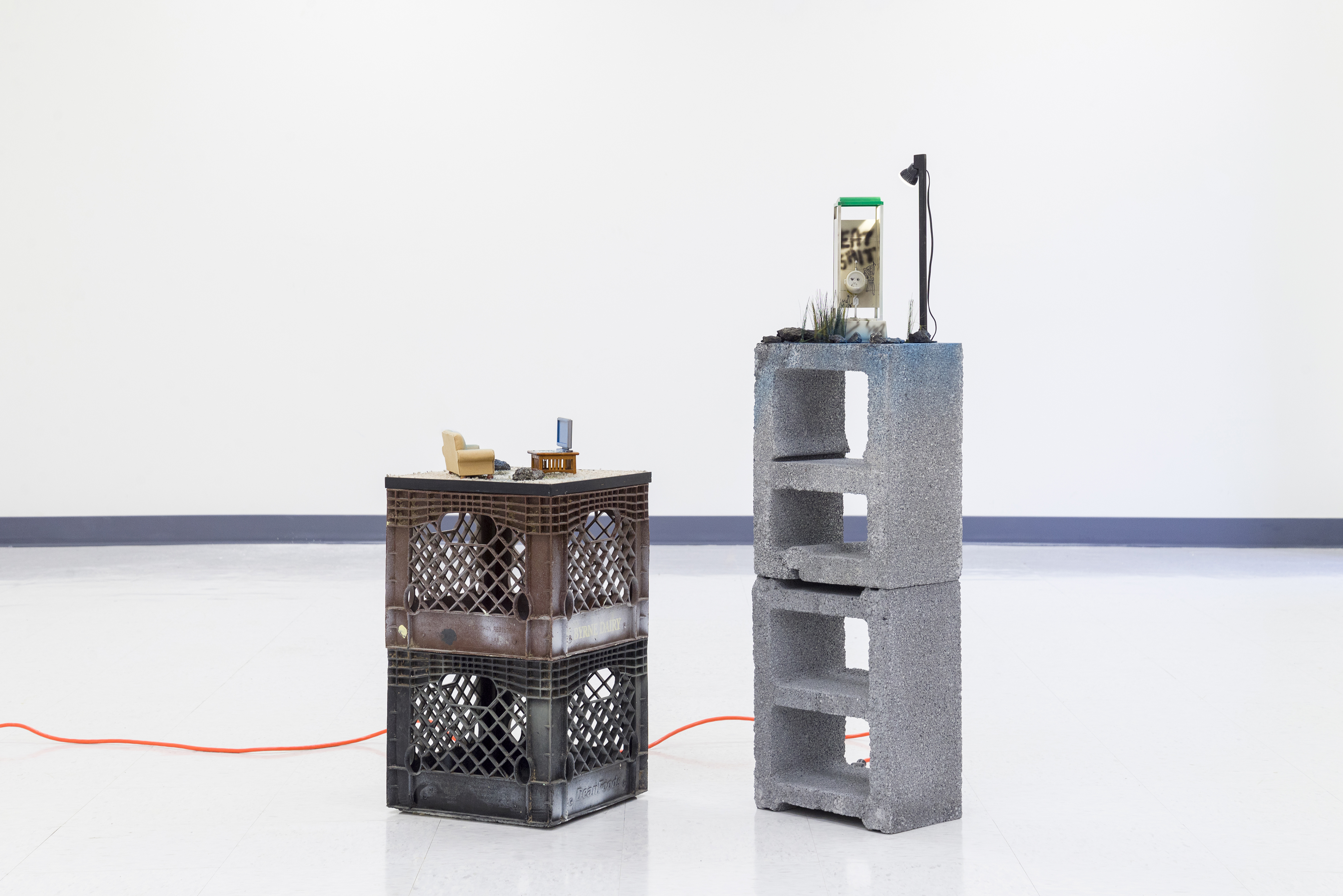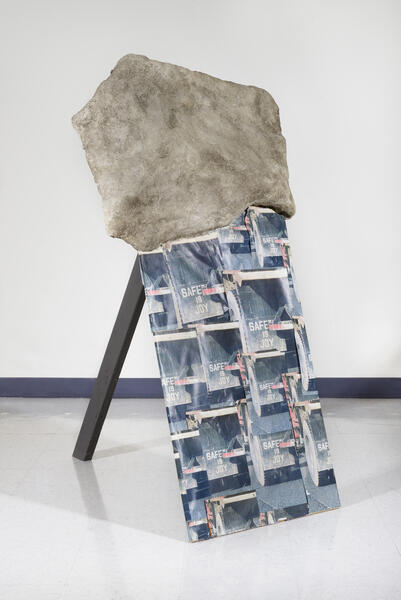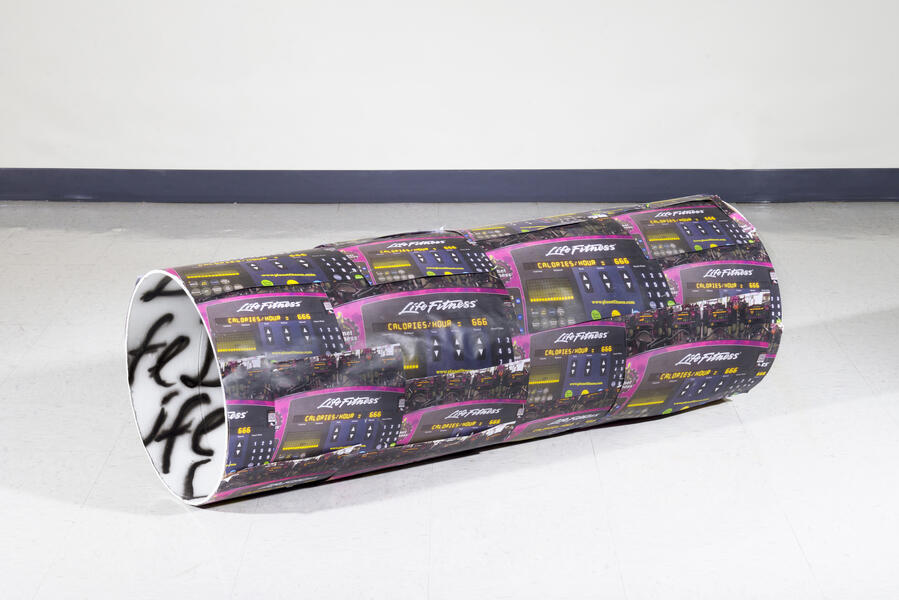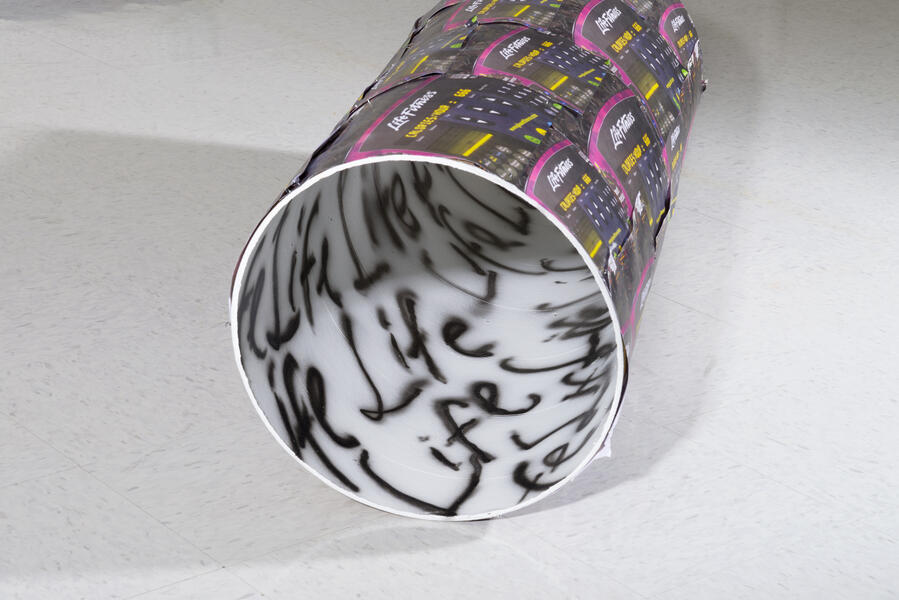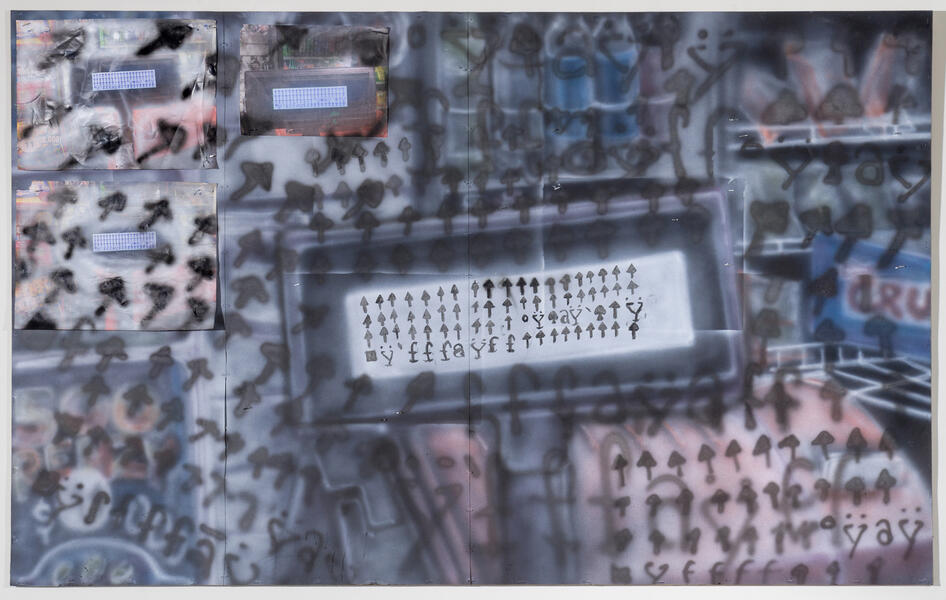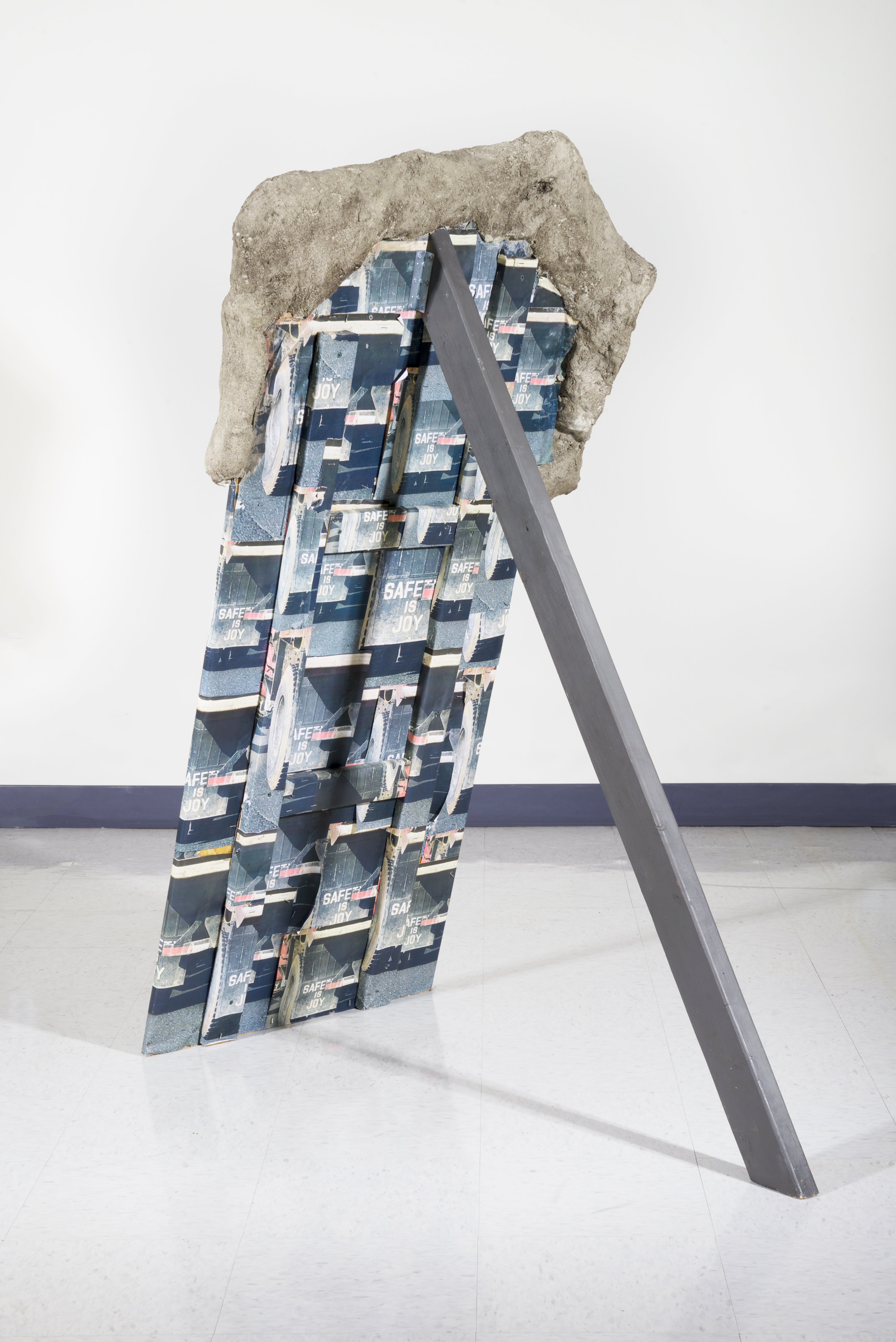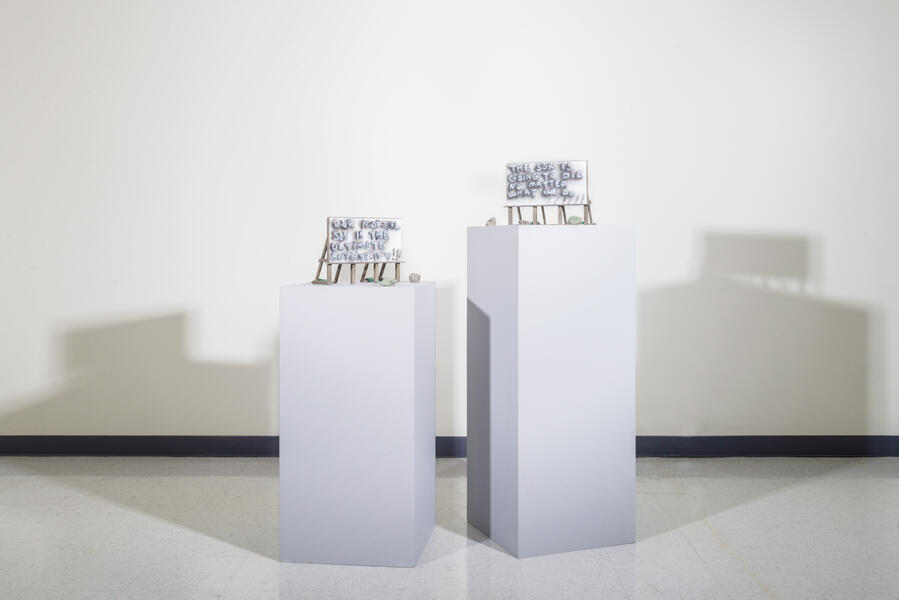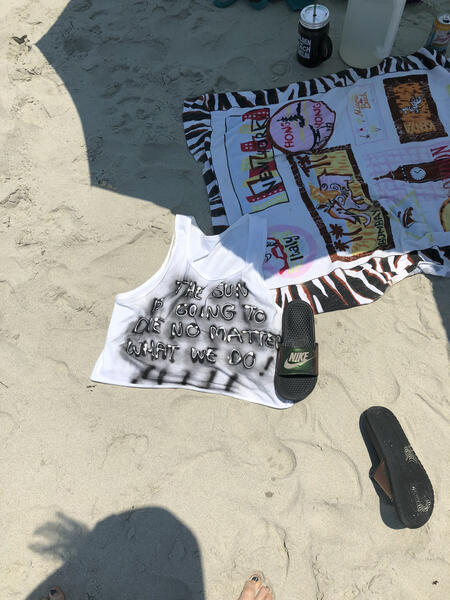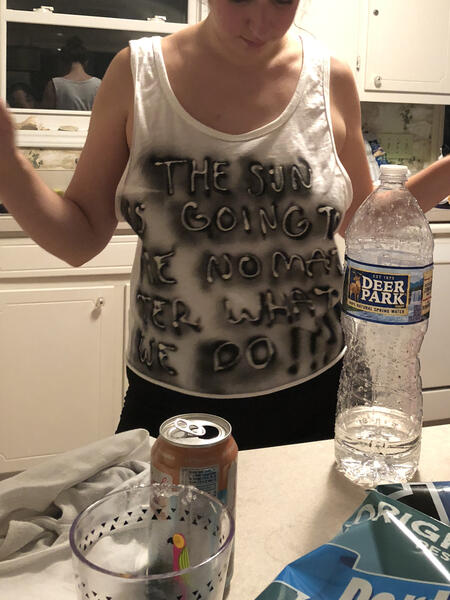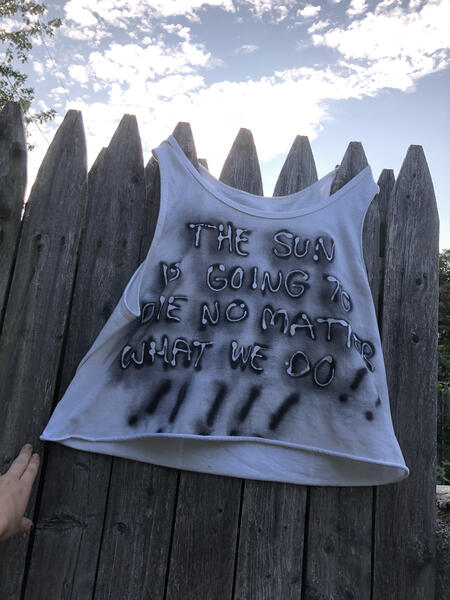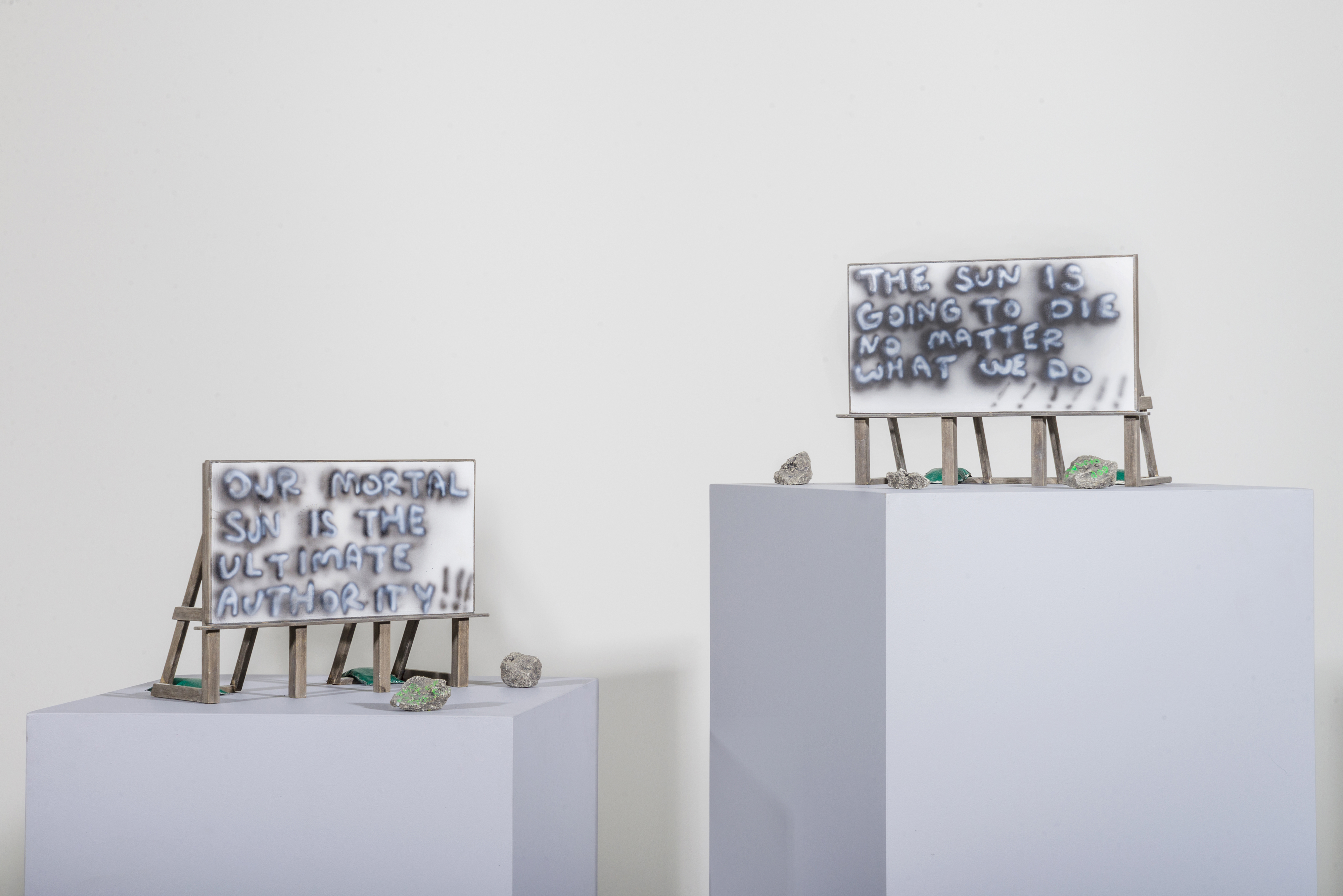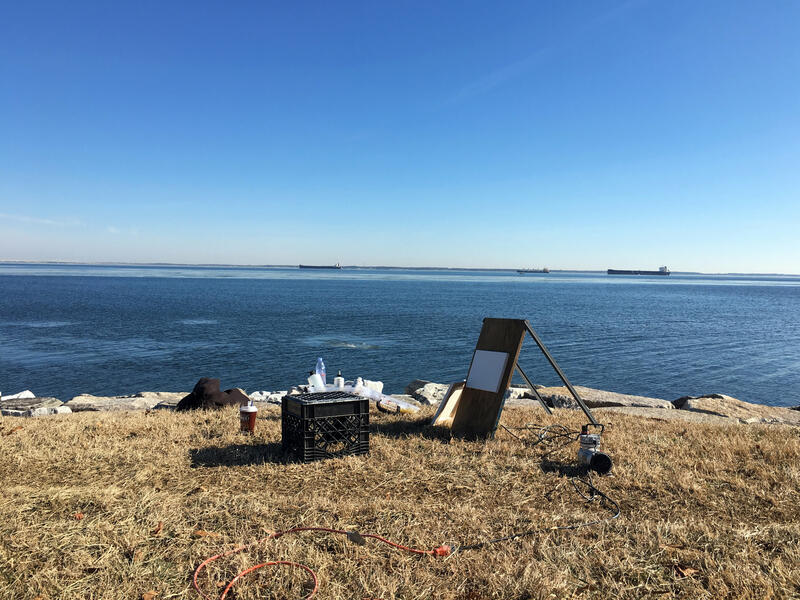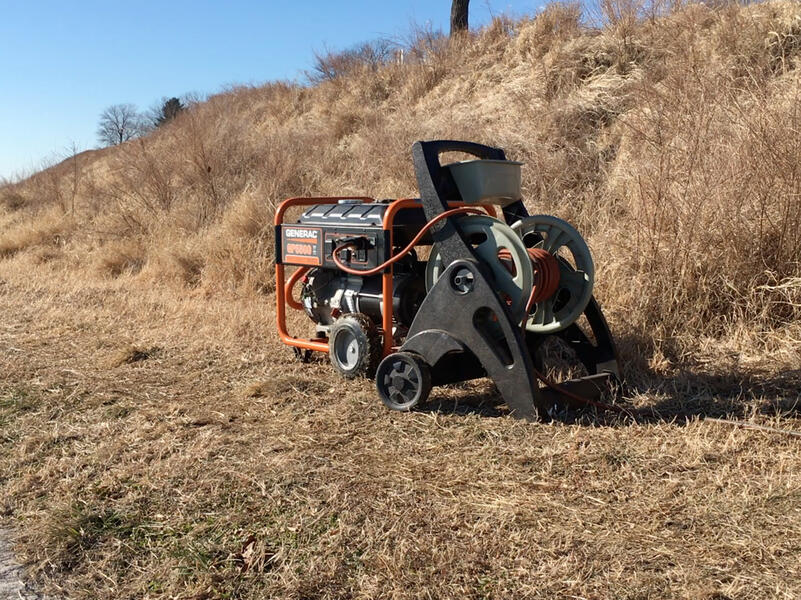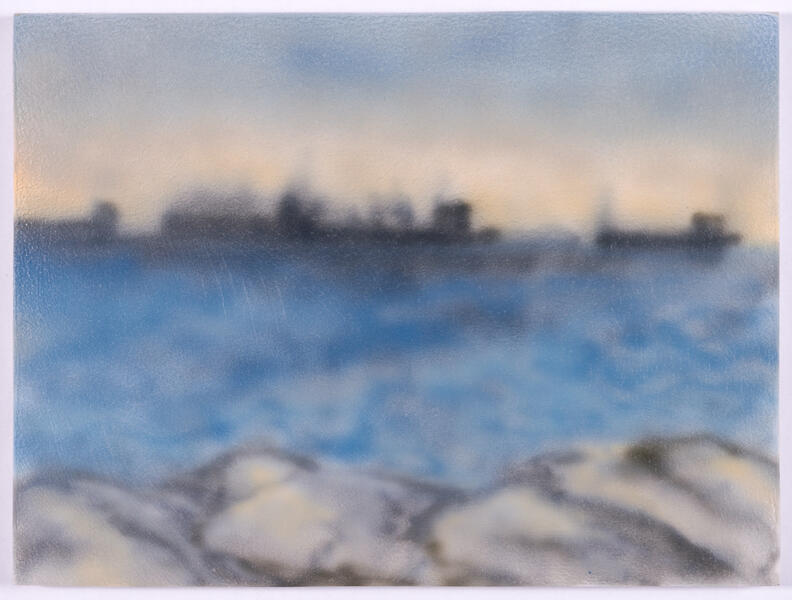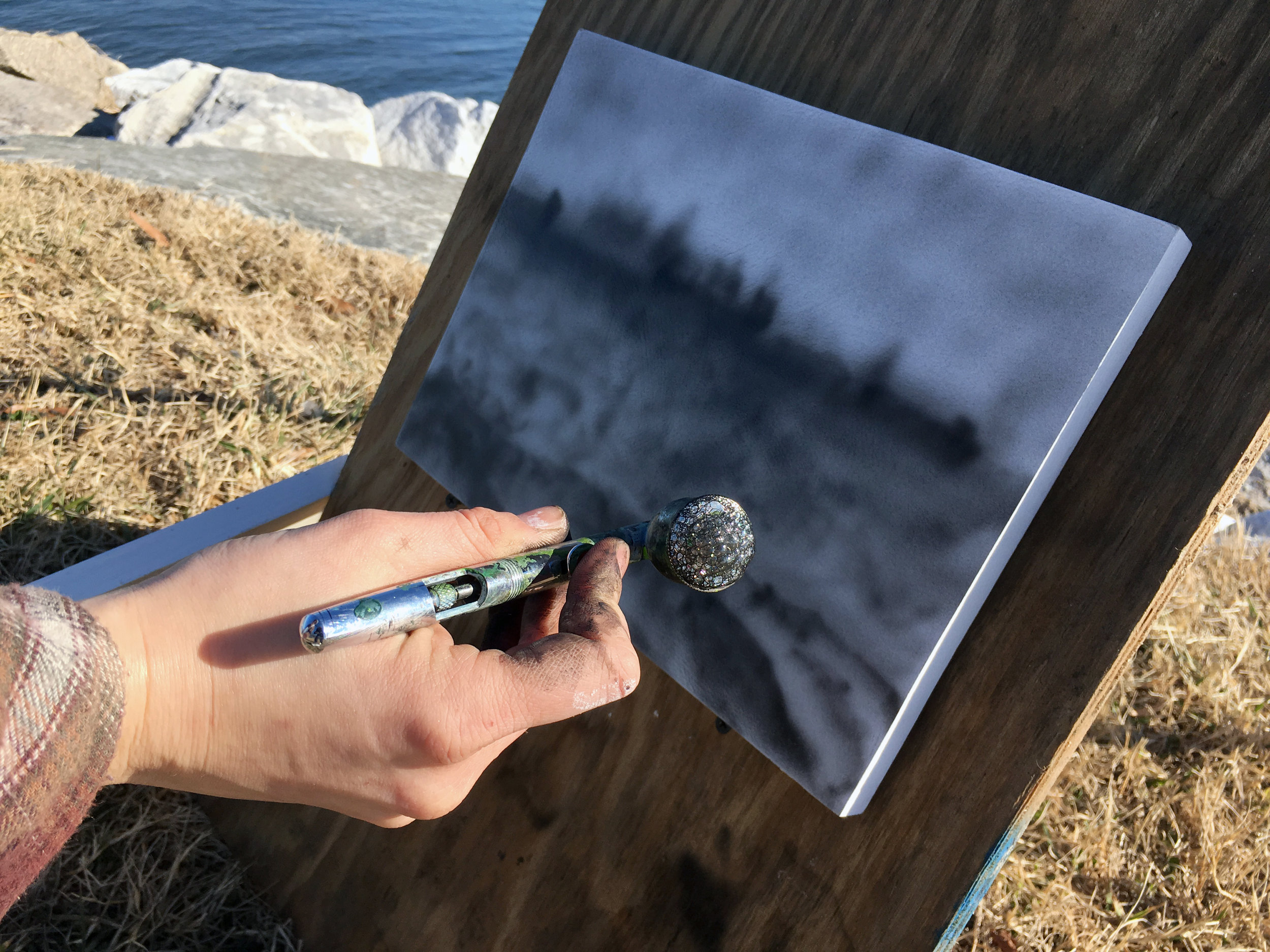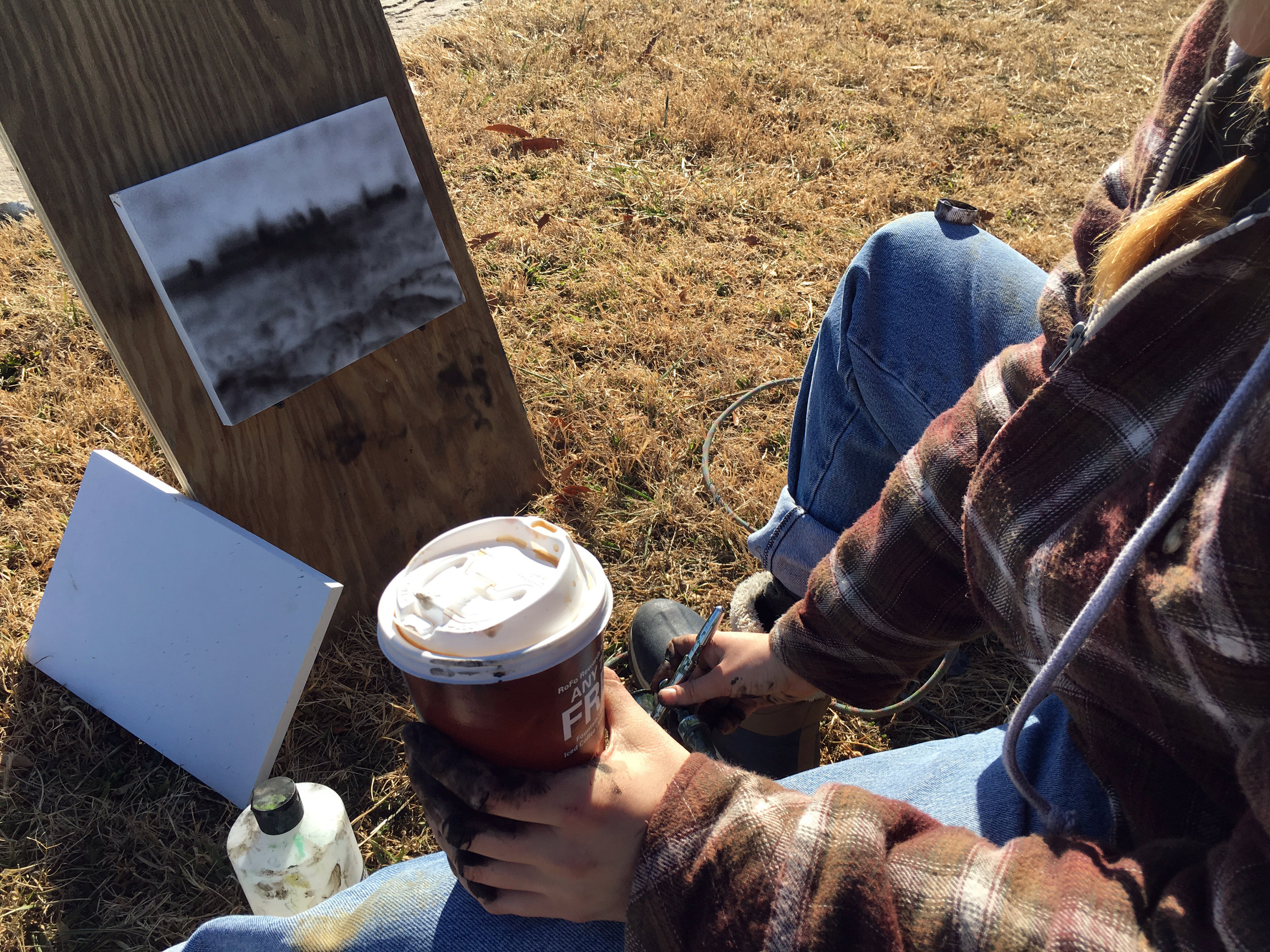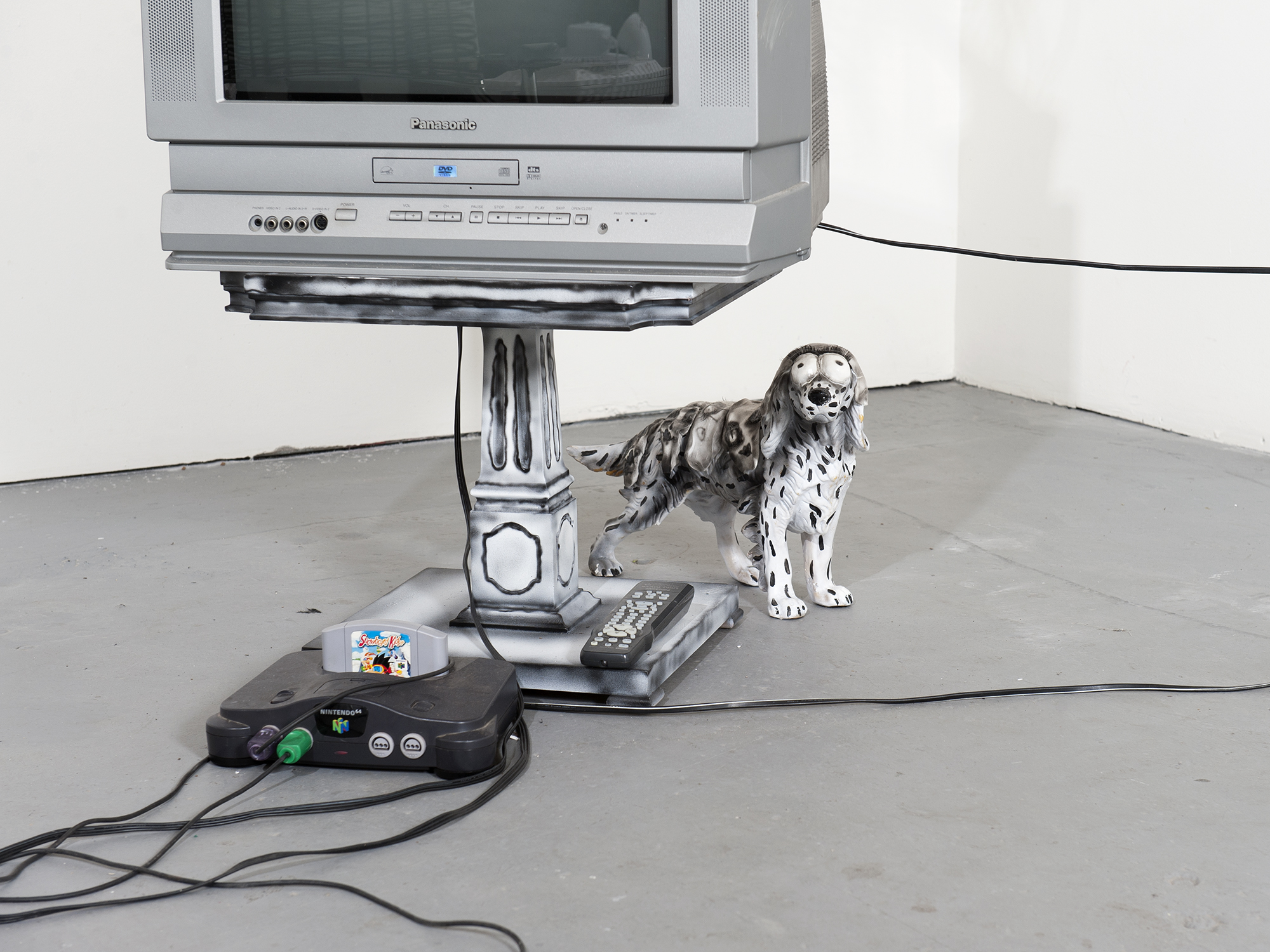Work samples
-
Finale (Celestial, Terrestrial)Featured is the Finale of Celestial, Terrestrial (2018); a two night exhibition at the Maryland Space Grant Observatory at Johns Hopkins University. The work sought to bridge the gap between Baltimore’s art and science communities while providing a platform for critical discussion of our relationship to, and place within the cosmos. Inside the Observation dome I spun an immersive installation that celebrates the space and its telescope as a surreal juncture of Earth and cosmos; where we can experience out there and right here directly and concurrently.
-
 American Landscapes (Port-a-John)My ongoing series American Landscapes uses the nostalgic language of model making to imagine potent human habitats lost to time and neglect. Here the port-a-john is remembered for its poetic qualities; its graffiti being the only evidence of human intervention — save the single streetlight illuminating its interior. The work plays with the unique viewing experience of miniatures — allowing viewers to take the whole of a scene in one eyeful while also drawing them close to comb for details. Ultimately providing a more detailed picture of a thing. The landscapes are set on junk pedestals so from afar the miniature world blend into a pile of urban ephemera.
American Landscapes (Port-a-John)My ongoing series American Landscapes uses the nostalgic language of model making to imagine potent human habitats lost to time and neglect. Here the port-a-john is remembered for its poetic qualities; its graffiti being the only evidence of human intervention — save the single streetlight illuminating its interior. The work plays with the unique viewing experience of miniatures — allowing viewers to take the whole of a scene in one eyeful while also drawing them close to comb for details. Ultimately providing a more detailed picture of a thing. The landscapes are set on junk pedestals so from afar the miniature world blend into a pile of urban ephemera. -
 (I think I know) Safety is JoyMy ongoing series I Think I Know is the result of time spent mining images of malfunctions and anomalies from Baltimore’s cityscape. A glitched out lottery terminal, a satanic treadmill, a message from a mudflap; all these moments suggesting things are not quite as they should be. Through the work I participate in the physical world in the same way I do the digital — on constant alert for new information. I use repetition of imagery to mimic the feeling of a screen overrun by content, evoking the fear of missing out on new media — or the alarming rate at which I consume it.
(I think I know) Safety is JoyMy ongoing series I Think I Know is the result of time spent mining images of malfunctions and anomalies from Baltimore’s cityscape. A glitched out lottery terminal, a satanic treadmill, a message from a mudflap; all these moments suggesting things are not quite as they should be. Through the work I participate in the physical world in the same way I do the digital — on constant alert for new information. I use repetition of imagery to mimic the feeling of a screen overrun by content, evoking the fear of missing out on new media — or the alarming rate at which I consume it. -
 No More Sun!No More Sun! Is an immersive installation/apocalyptic bunker-lounge set in near total grayscale; the work took place in mid-July in a hot warehouse. The work uses the absence of color and the presence of heat as workable materials. Here, viewers are invited to sit in No More Sun! branded lawn chairs and play “Snowboarding Kids;” splicing their experience between a snowy mountain and a humid warehouse.
No More Sun!No More Sun! Is an immersive installation/apocalyptic bunker-lounge set in near total grayscale; the work took place in mid-July in a hot warehouse. The work uses the absence of color and the presence of heat as workable materials. Here, viewers are invited to sit in No More Sun! branded lawn chairs and play “Snowboarding Kids;” splicing their experience between a snowy mountain and a humid warehouse.
About Sara
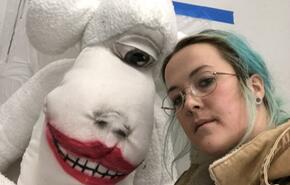
Celestial, Terrestrial
Celestial, Terrestrial (2018) was a two night event that took place at the Maryland Space Grant Observatory at Johns Hopkins University. The exhibition sought to bridge the gap between Baltimore’s art and science communities while providing a platform for critical discussion of our relationship to, and place within the cosmos. The two-part exhibition was host to a group show I curated on the deck and a solo show of my work within the observatory. Inside the Observation dome I spun an immersive installation that celebrates the space and its telescope as a surreal juncture of Earth and cosmos; where we can experience out there and right here directly and concurrently.
Inside the space objects behave strangely, scales shift unexpectedly and Bobby Darin’s “Beyond the Sea” plays sluggishly, slowed from 136 to 18 BPM. The concept of an “observatory” is stretched, kneaded and inverted. A halloween decoration is recontextualized into the dome — now acting as a readymade reverse telescope; projecting a "spooky lady” wriggling above the crowd. Viewers can reflect while watching live crickets lounge dumbly on a couch in Cricket Observatory; miniature elements from the cricket’s tank repeat large scale throughout the installation.
The Morris W. Offit telescope stays trained on the quarter moon; periodically adjusting itself, causing the telescope to slew and the domed roof to rotate sporadically. The telescope is mimicked and mocked by two decoy telescopes; leveling the playing fields by presenting Earth objects and celestial bodies in the same viewing plane. The viewers are encouraged to dose a mouthful of Pop Rocks — activating an unexpected sense. The candy’s crackling sensation combined with the granular detail of the lunar surface creates a feeling akin to licking the moon — claiming the moon as a material by experiencing it on my tongue.
-
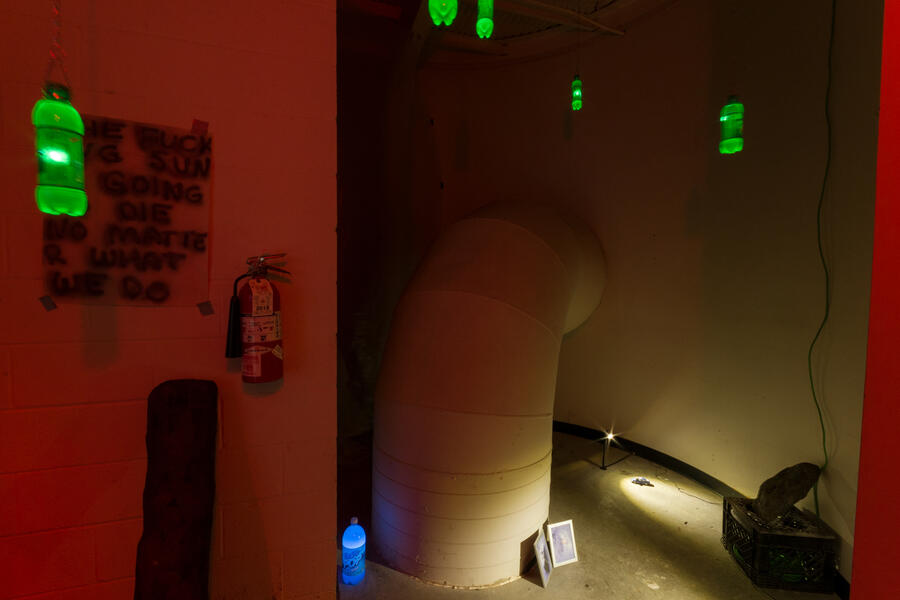 Celestial, TerrestrialThe viewer of Celestial, Terrestrial interacts with three distinct spaces on their way up to the Morris W. Offit telescope; this spherical foyer is the access point to the Maryland Space Grant Observatory. On this floor the viewers weave through a flock of mountain dew fueled lanterns to the tune of Bobby Darin’s “Beyond the Sea” slowed from 136 to 18 BPM. The manipulation of light and sound sets a disorienting, sluggish atmosphere where vernacular objects begin to behave strangely — emphasizing the intersection of Earth and the cosmos unique to an observatory.
Celestial, TerrestrialThe viewer of Celestial, Terrestrial interacts with three distinct spaces on their way up to the Morris W. Offit telescope; this spherical foyer is the access point to the Maryland Space Grant Observatory. On this floor the viewers weave through a flock of mountain dew fueled lanterns to the tune of Bobby Darin’s “Beyond the Sea” slowed from 136 to 18 BPM. The manipulation of light and sound sets a disorienting, sluggish atmosphere where vernacular objects begin to behave strangely — emphasizing the intersection of Earth and the cosmos unique to an observatory. -
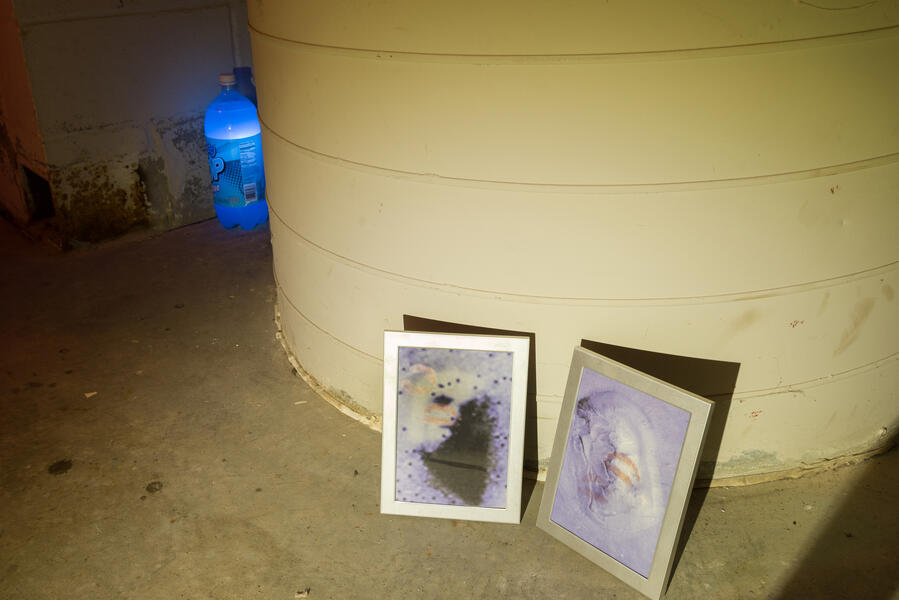 I love you both ways, Cydonia(Front, right) Featured here are two photographs of the same rock formation in the Cydonia region of Mars. The image on the left was captured by the Viking 1 Spacecraft in 1976; the image on the right by the Mars Global Surveyor in 2001. The first image caused a rise of conspiracy theories and fandom based around the “Face on Mars;”only to be debunked 25 years later by the second image. In a gesture of compassion I gave both representations kisses to show my equal appreciation for their relative truths.
I love you both ways, Cydonia(Front, right) Featured here are two photographs of the same rock formation in the Cydonia region of Mars. The image on the left was captured by the Viking 1 Spacecraft in 1976; the image on the right by the Mars Global Surveyor in 2001. The first image caused a rise of conspiracy theories and fandom based around the “Face on Mars;”only to be debunked 25 years later by the second image. In a gesture of compassion I gave both representations kisses to show my equal appreciation for their relative truths. -
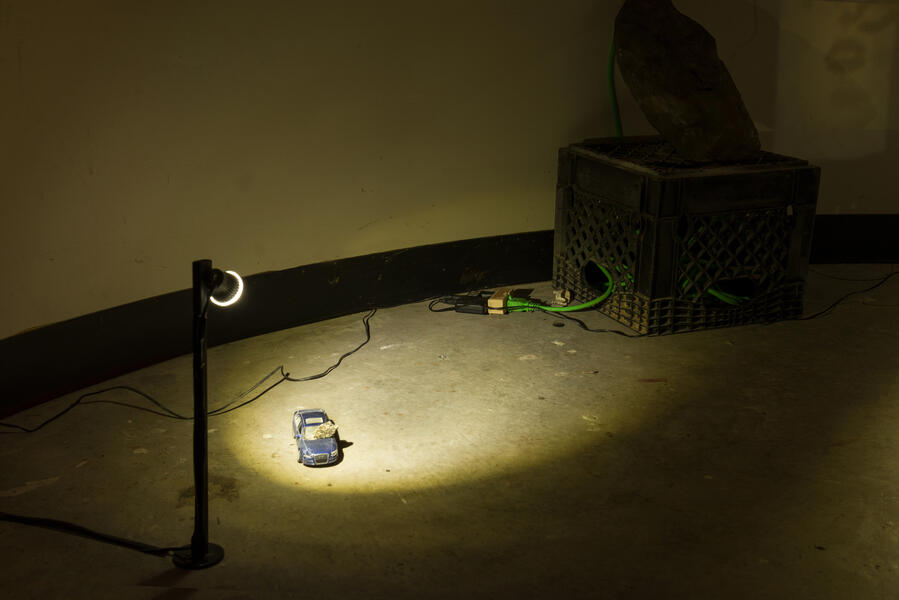 Car Crash (Celestial, Terrestrial)A car crash caused by a miniature meteorite draws viewers close to cosmic interference.
Car Crash (Celestial, Terrestrial)A car crash caused by a miniature meteorite draws viewers close to cosmic interference. -
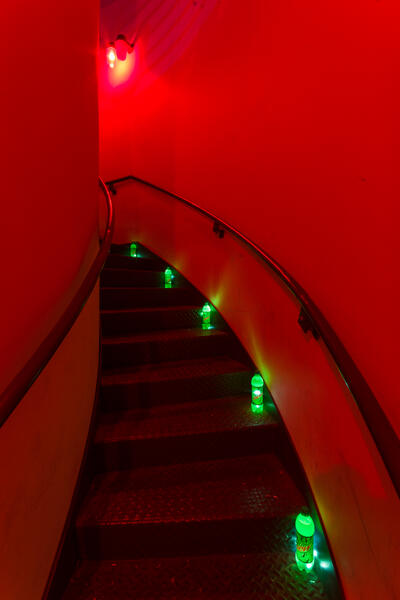 Mountain Dew Lanterns (Celestial, Terrestrial)Mountain Dew becomes lantern fuel — emphasizing the counterintuitive nature of drinking thick, fluorescent liquid; imaging someone unfamiliar with its purpose putting it to a more appropriate use.
Mountain Dew Lanterns (Celestial, Terrestrial)Mountain Dew becomes lantern fuel — emphasizing the counterintuitive nature of drinking thick, fluorescent liquid; imaging someone unfamiliar with its purpose putting it to a more appropriate use. -
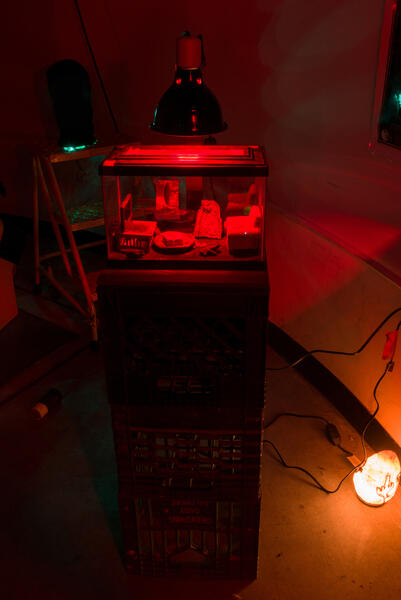 Cricket ObservatoryThe crickets in Cricket Observatory are manic, yet passive participants living in this familiar habitat, inexplicably spending their time lounging on an armchair. Elements of this miniature work are echoed throughout Celestial,Terrestrial. The rock drawing of the urinating Alien is a reproduction of a large scale slab on the observatory deck; the viewers stand on a life-size version of the cricket’s carpeted floor when looking through the Morris W. Offit telescope — the work and it’s miniature inhabitants continue the pattern of disorienting scale shifts present throughout the installation.
Cricket ObservatoryThe crickets in Cricket Observatory are manic, yet passive participants living in this familiar habitat, inexplicably spending their time lounging on an armchair. Elements of this miniature work are echoed throughout Celestial,Terrestrial. The rock drawing of the urinating Alien is a reproduction of a large scale slab on the observatory deck; the viewers stand on a life-size version of the cricket’s carpeted floor when looking through the Morris W. Offit telescope — the work and it’s miniature inhabitants continue the pattern of disorienting scale shifts present throughout the installation. -
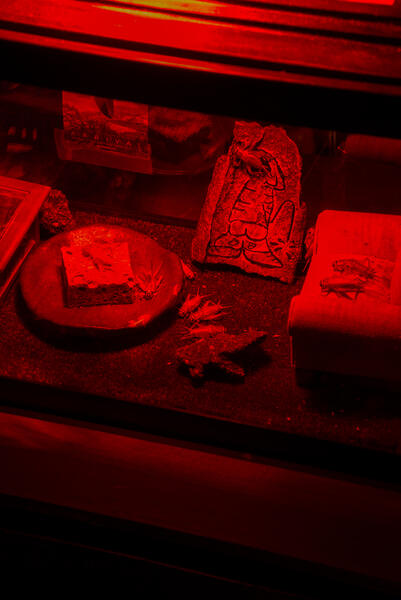 Cricket Observatory (detail; Celestial, Terrestrial)
Cricket Observatory (detail; Celestial, Terrestrial) -
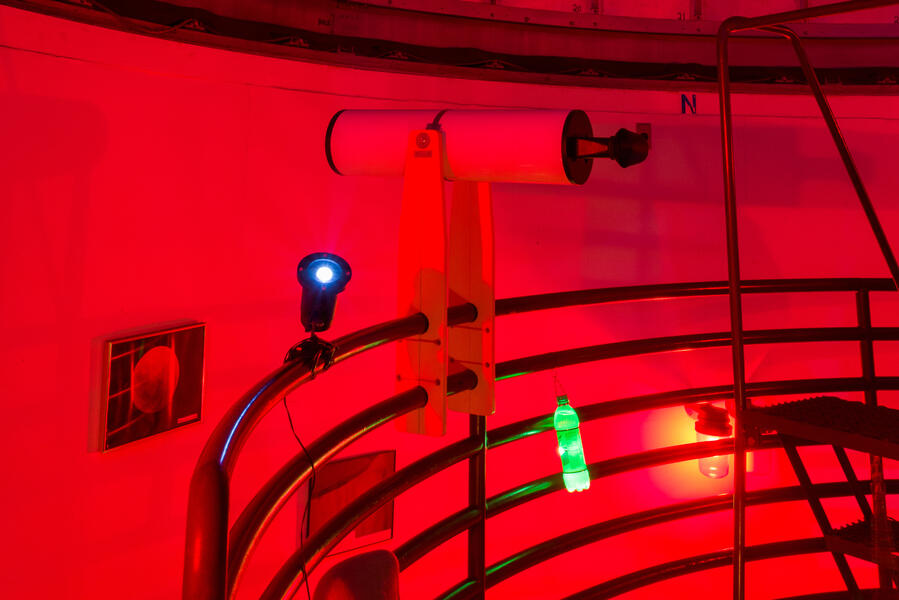 Decoy TelescopeThe Decoy Telescopes were designed to mimic the aesthetic of the Morris W. Offit telescope of the Maryland Space Grant Observatory. They mocked the gaze through their parent’s lens by offering views of frivolous Earth objects floating in a celestial void. The viewers were surprised to learn they were not a permanent part of the observatory when they looked through the lens to see a demonic George Washington and a car keyed with the words “u r a dick” (not pictured).
Decoy TelescopeThe Decoy Telescopes were designed to mimic the aesthetic of the Morris W. Offit telescope of the Maryland Space Grant Observatory. They mocked the gaze through their parent’s lens by offering views of frivolous Earth objects floating in a celestial void. The viewers were surprised to learn they were not a permanent part of the observatory when they looked through the lens to see a demonic George Washington and a car keyed with the words “u r a dick” (not pictured). -
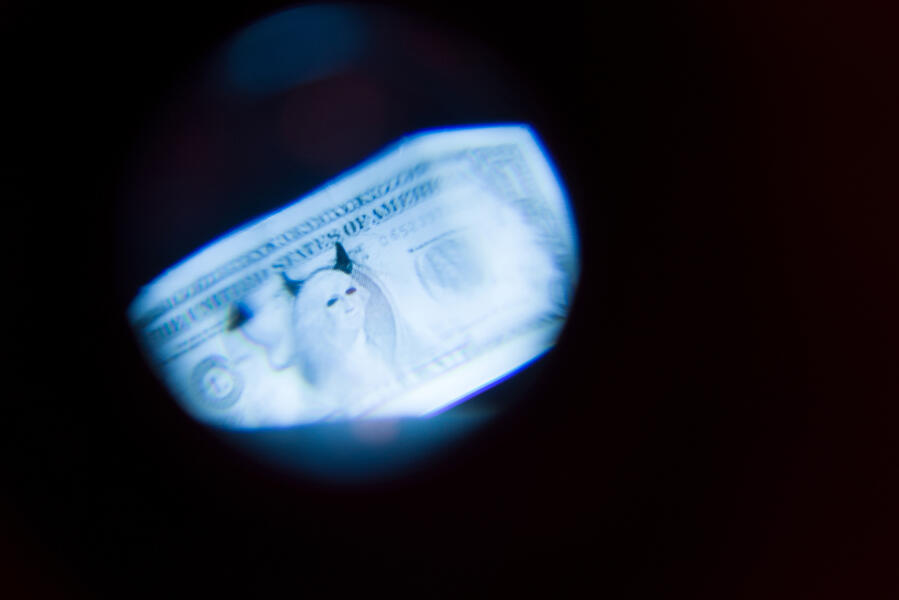 Decoy Telescope (detail view through lens; Celestial, Terrestrial)
Decoy Telescope (detail view through lens; Celestial, Terrestrial) -
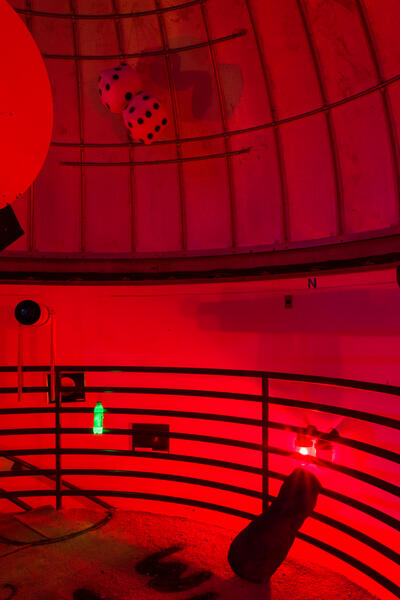 Celestial, Terrestrial
Celestial, Terrestrial -
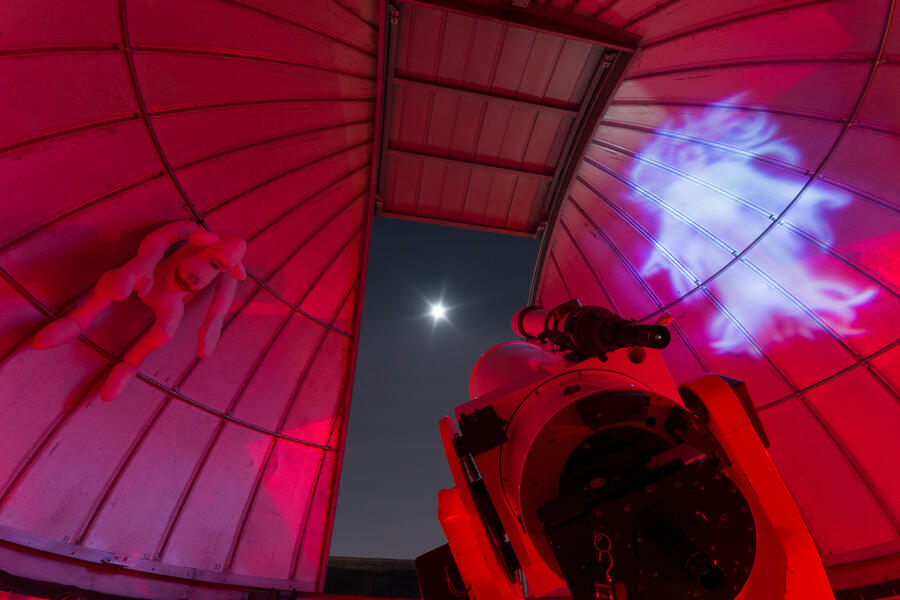 Celestial, TerrestrialThe Morris W. Offit telescope stayed trained on the quarter moon. It automatically adjusted itself; periodically causing the domed roof to rotate, the telescope to slew, the cyclops to jiggle and the ghost to soar. The viewers were offered pop rocks to hold in their mouth while they looked through the telescope. The candy’s crackling sensation combined with the highly detailed lunar view created a feeling akin to licking the moons craters — activating an unexpected sense, claiming the moon as a material by experiencing it on my tongue.
Celestial, TerrestrialThe Morris W. Offit telescope stayed trained on the quarter moon. It automatically adjusted itself; periodically causing the domed roof to rotate, the telescope to slew, the cyclops to jiggle and the ghost to soar. The viewers were offered pop rocks to hold in their mouth while they looked through the telescope. The candy’s crackling sensation combined with the highly detailed lunar view created a feeling akin to licking the moons craters — activating an unexpected sense, claiming the moon as a material by experiencing it on my tongue.
American Landscapes
My ongoing series American landscapes uses the nostalgic language of model making to imagine potent human habitats lost to time and neglect. The work plays with the unique viewing experience of miniatures — allowing viewers to take the whole of a scene in one eyeful while also drawing them close to comb for details. Ultimately providing a more detailed picture of a thing. The landscapes are set on junk pedestals so from afar the miniature worlds blend into a pile of urban ephemera.
-
 American Landscapes
American Landscapes -
 American Landscapes (Living Room Swamp)In American Landscapes (Living Room Swamp) an abandoned television’s default screen casts a blue hue across a familiar scene; a scene made strange by shallow water pooling on the floor. Living Room Swamp describes the inherent stillness of the living room, finding parallels between it and uncultivated marsh land. Shag carpet becomes swamp grass, rocks replace furnishings and the couch sprouts moss — emphasizing the inert nature of the space while acknowledging its quiet comfort.
American Landscapes (Living Room Swamp)In American Landscapes (Living Room Swamp) an abandoned television’s default screen casts a blue hue across a familiar scene; a scene made strange by shallow water pooling on the floor. Living Room Swamp describes the inherent stillness of the living room, finding parallels between it and uncultivated marsh land. Shag carpet becomes swamp grass, rocks replace furnishings and the couch sprouts moss — emphasizing the inert nature of the space while acknowledging its quiet comfort. -
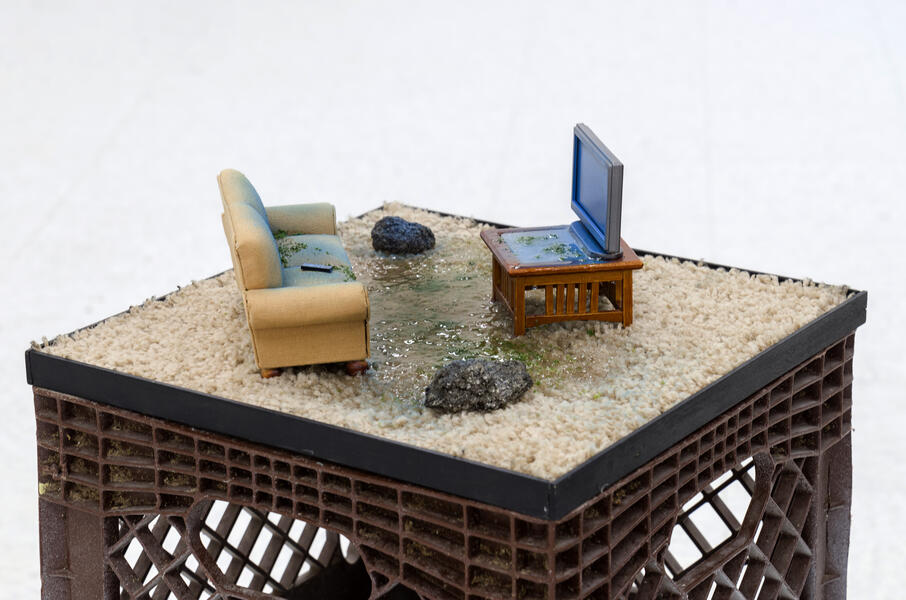 American Landscapes (Living Room Swamp)
American Landscapes (Living Room Swamp) -
 American Landscapes (Port-a-John)By day I work construction, where I encounter the rawest of human environments — the port-a-john. The walls of the portable toilet are an open book to the workers soul; sometimes poetic, often offensive, mostly rough, quick uncensored prose. The port-a-john gives no other option than primal honesty. Here, it is remembered for its poetic qualities; its graffiti being the only evidence of human intervention, save the single streetlight illuminating its interior. I look romantically back at the portable toilet; memorializing it in one of a series of trashed human habitats; using an airbrush to scrawl miniature graffiti across a 1:12 model from Japan.
American Landscapes (Port-a-John)By day I work construction, where I encounter the rawest of human environments — the port-a-john. The walls of the portable toilet are an open book to the workers soul; sometimes poetic, often offensive, mostly rough, quick uncensored prose. The port-a-john gives no other option than primal honesty. Here, it is remembered for its poetic qualities; its graffiti being the only evidence of human intervention, save the single streetlight illuminating its interior. I look romantically back at the portable toilet; memorializing it in one of a series of trashed human habitats; using an airbrush to scrawl miniature graffiti across a 1:12 model from Japan.
I think I know
The Good News
Plein Airbrush
No More Sun!
-
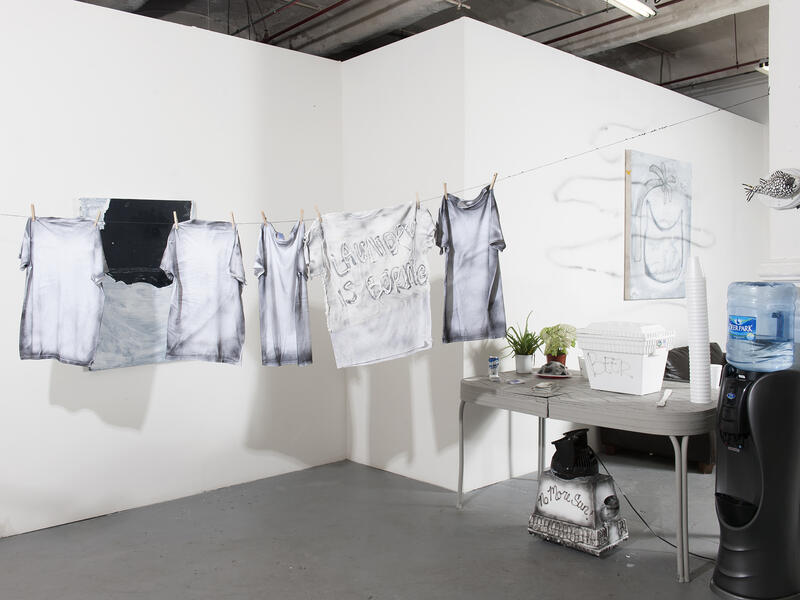 Laundry Room (No More Sun!)No More Sun! is an immersive installation/ apocalyptic bunker-lounge set in near total grayscale. The show took place in mid-July in the context of Alloverstreet, a monthly art walk primarily located inside a hot Baltimore warehouse. The installation uses the summer heat as a workable material; guests of Alloverstreet were invited to come, stay a while, cool off and forget where they are.
Laundry Room (No More Sun!)No More Sun! is an immersive installation/ apocalyptic bunker-lounge set in near total grayscale. The show took place in mid-July in the context of Alloverstreet, a monthly art walk primarily located inside a hot Baltimore warehouse. The installation uses the summer heat as a workable material; guests of Alloverstreet were invited to come, stay a while, cool off and forget where they are. -
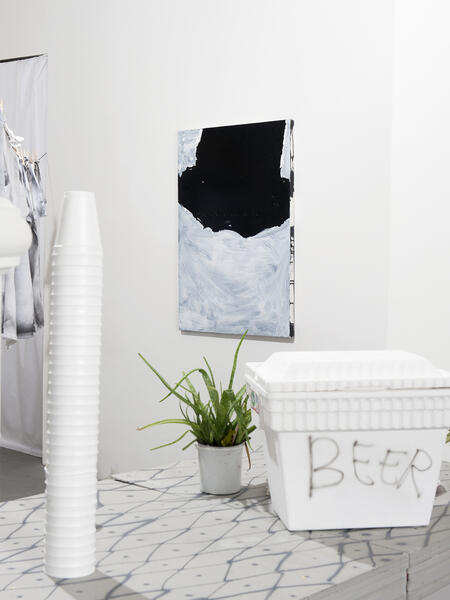 Front Desk (No More Sun!)
Front Desk (No More Sun!) -
 Air Conditioned Living Room (No More Sun!)Pictured here is one of the lounge areas cooled by two home made air conditioning units. Fans blow air over a block of ice, out an elbow vent and onto the guests of No More Sun! while the soundtrack to “Adventures in Paradise” hums sleepily on repeat.
Air Conditioned Living Room (No More Sun!)Pictured here is one of the lounge areas cooled by two home made air conditioning units. Fans blow air over a block of ice, out an elbow vent and onto the guests of No More Sun! while the soundtrack to “Adventures in Paradise” hums sleepily on repeat. -
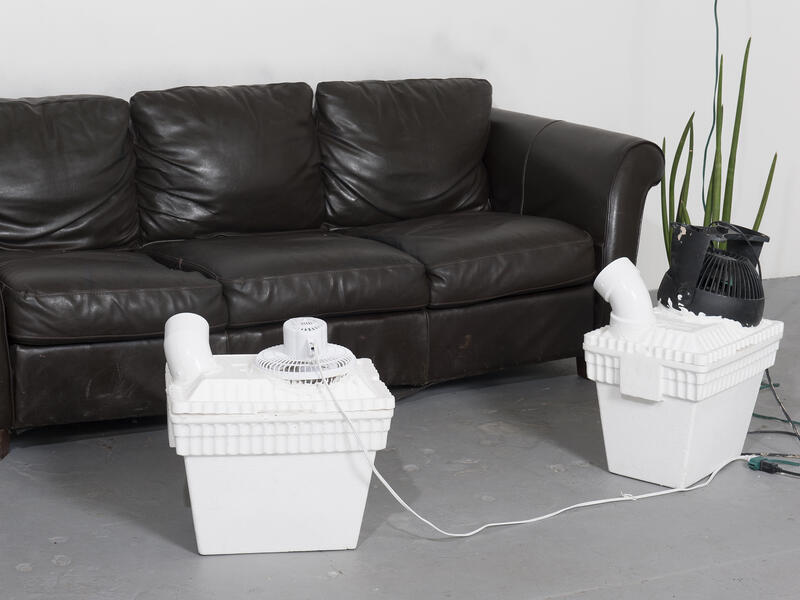 Air Conditioned Living Room (detail; No More Sun!)
Air Conditioned Living Room (detail; No More Sun!) -
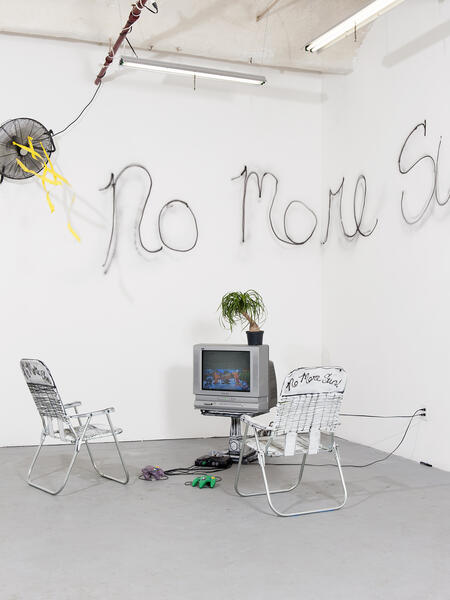 No More Sun!No More Sun! uses the absence of color to remove the bunker-lounge from normal sensibility; objects are contoured and re-shaded to appear under the influence of some unknown light source. The illusion stutters around ordinary full-color objects, which become the new exception. Viewers are invited to sit in No More Sun! branded lawn chairs and play “Snowboarding Kids;” splicing their experience between a snowy mountain and a humid warehouse.
No More Sun!No More Sun! uses the absence of color to remove the bunker-lounge from normal sensibility; objects are contoured and re-shaded to appear under the influence of some unknown light source. The illusion stutters around ordinary full-color objects, which become the new exception. Viewers are invited to sit in No More Sun! branded lawn chairs and play “Snowboarding Kids;” splicing their experience between a snowy mountain and a humid warehouse. -
 Anxious Dog (No More Sun!)
Anxious Dog (No More Sun!) -
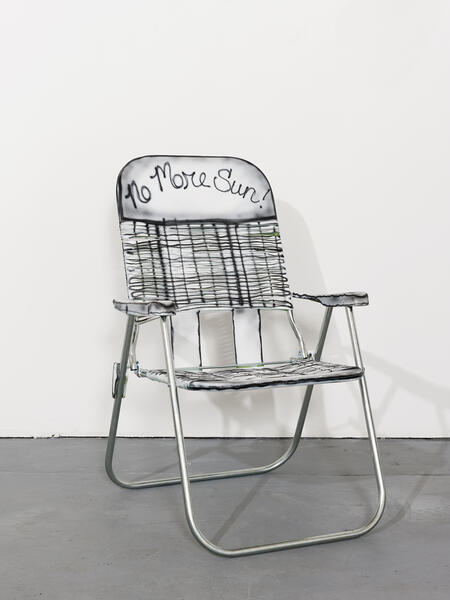 No More Sun! branded Lawn Chair
No More Sun! branded Lawn Chair -
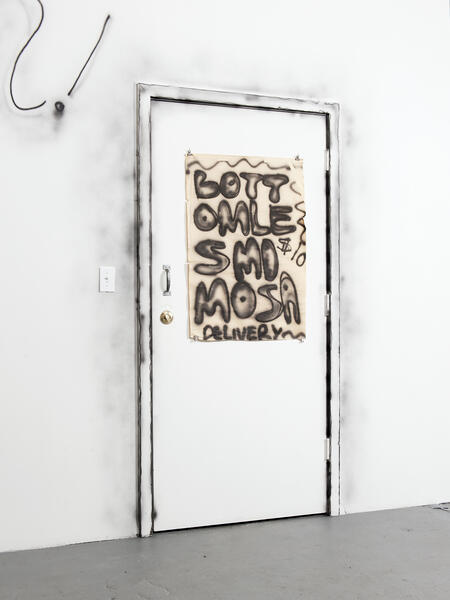 Bottemless Mimosa Delivery Service (No More Sun!)No More Sun! evokes tactics used by casinos and resorts to coax guests into lethargic submission. Pictured here is an advertisement for bottomless mimosa delivery to the bunker-lounge; a business which would be both profitless and inefficient, adding to the absurdity of the space and the promises of the resort.
Bottemless Mimosa Delivery Service (No More Sun!)No More Sun! evokes tactics used by casinos and resorts to coax guests into lethargic submission. Pictured here is an advertisement for bottomless mimosa delivery to the bunker-lounge; a business which would be both profitless and inefficient, adding to the absurdity of the space and the promises of the resort. -
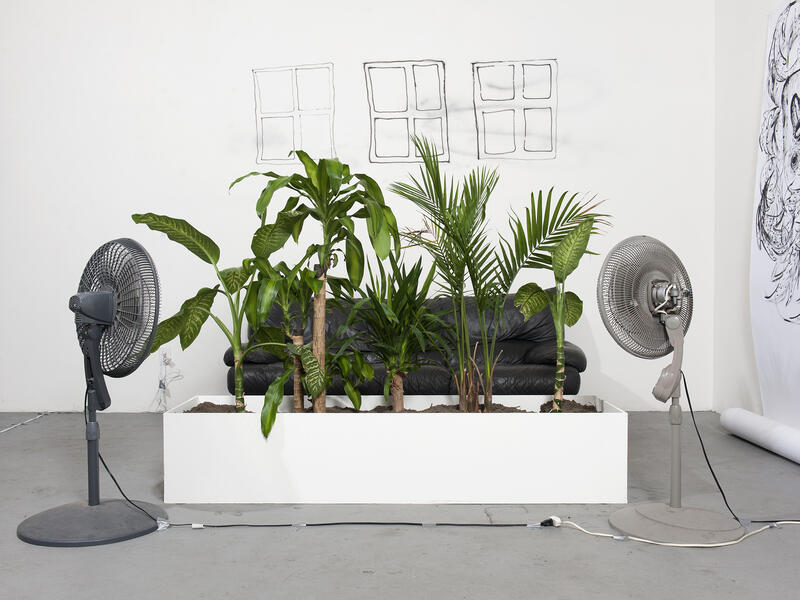 Sun Room with a Breeze (No More Sun!)Like a casino, the bunker-lounge has no natural light nor indication of time. However, No More Sun! offers a simulated sun room experience complete with a gentle breeze and rustling tropical plants. The installation plays on the idea of creating a false “paradise,” utilizing repetitive, hypnotic music and comfortable conditions to entice guests into coming back for more.
Sun Room with a Breeze (No More Sun!)Like a casino, the bunker-lounge has no natural light nor indication of time. However, No More Sun! offers a simulated sun room experience complete with a gentle breeze and rustling tropical plants. The installation plays on the idea of creating a false “paradise,” utilizing repetitive, hypnotic music and comfortable conditions to entice guests into coming back for more.










